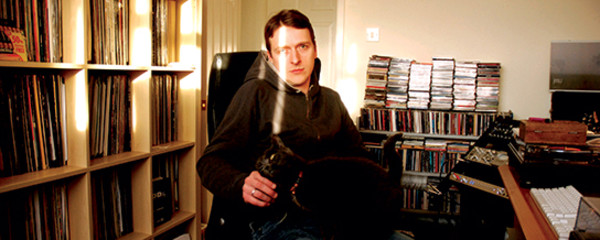Justin Broadrick In The Studio
Since defining grindcore with Napalm Death when he was only 15, Justin Broadrick has made […]
Justin Broadrick In The Studio
Since defining grindcore with Napalm Death when he was only 15, Justin Broadrick has made […]

Since defining grindcore with Napalm Death when he was only 15, Justin Broadrick has made a career out of destroying and rebuilding the rules of heavy music. Best known for his role in the seminal metal band Godflesh, Broadrick’s many aliases mask a discography of genre-spanning experimentation. His work with Kevin Martin (a.k.a. The Bug) as Techno Animal predates the half-step pacing of dubstep; solo aliases like Tech Level 2 and Final explore everything from drum & bass to ambient drone.
Broadrick’s newest project, Jesu, continues with the singular vision that has always fueled his best work. Heavily layered and massively epic, albums like Jesu’s Conqueror are rooted in rock, but use few of the traditional tricks of the trade. In fact, Broadrick’s technique owes more to drum & bass and electronic music than anything rock music purists would ever try.
XLR8R: Why did you use a drum machine with Godflesh?
Justin Broadrick: I was in this band Head of David, where I was drumming, so by the time we formed Godflesh, I had a very clear idea of the type of beats I wanted to hear. And the beats I wanted to hear would take four arms, you know what I mean? I was just obsessed with making the sound as massive as possible. And when Godflesh was formed in ’88, it was after some of my favorite hip-hop records of all time came out: Eric B. and Rakim’s Paid in Full and the first two Public Enemy albums. I wanted beats that sounded like that, but I knew a drummer wasn’t gonna pull it off.
The new Jesu album sounds massive. How did you do it?
All the stuff I learned from producing drum & bass [as Tech Level 2] I’ve applied to Jesu. Everything was so reprocessed against each other; two of the same kicks, reprocessed back in and out. It’s the same concept of layering in drum & bass–filling in a certain dynamic with different breakbeats.
So you’re re-sampling a lot of material?
Oh yeah. I really swear by putting things into other things, into other things, and so on. Running a sound from [Native Instruments] Kontakt out to my Avalon 737 [pre-amp /compressor/EQ unit], and back in again. So many fucking layers of stuff. You know, some of the source material of these sounds are just crap. I’ve got a project open right now here in Logic, and nothing is the original source.
What do you usually lean on for recording?
The Avalon is universal for me. I’ll put a kick drum, snare drum, hat, or a bass guitar into that. Any stereo sources I’ll generally put into a TL Audio parametric EQ. And I’ll drive everything; usually get it in the red. Then that all runs into a Macintosh [G5] and Logic… loads of plug-ins from there. I’ve been using these valve-emulating compressors lately [from] the URS Compressor suite. They’re absolutely brilliant.
Considering all the processing you do, how do you feel about playing live as Jesu?
From the most basic drum machines up to a G5, I’ve had fucking millions of crashes in every group. When Godflesh first came to the States, we had this little Alesis HR-16 drum machine, and we had to use this American power transformer. We came up on stage with this big triumphant announcement, “GODFLESH FROM ENGLAND,” just full of metal kids screaming; they didn’t know what the fuck was going on. So we literally walked on–kids going mental–pressed play on the drum machine, and it blew up. We had to buy a new one and reprogram all the songs on it! But I haven’t had too many problems with Jesu–touch wood. These Mac laptops have just gotten so much more reliable, and I keep telling people… that I feel like I can finally make music without having to reboot the computer every five minutes.
Drum & bass has informed so much of your production style. Have you kept up with scenes like dubstep?
It’s a strange thing for me, that whole movement. When it was garage, I loved it at first: the whole slowed-down drum & bass element of it. But now it’s splintered into so many things, and I’m more interested in the dubstep end of it. But like… are you familiar with a guy called Milanese? I just heard him a few weeks ago and I thought, “Fuckin’ hell! This is stuff Kevin Martin and I were touching on years ago.” I really liked it a lot. It was actually a relief for me to hear something like that in dance music. [Milanese] might not even be aware of our stuff, but it was nice to hear something running in that heritage.

